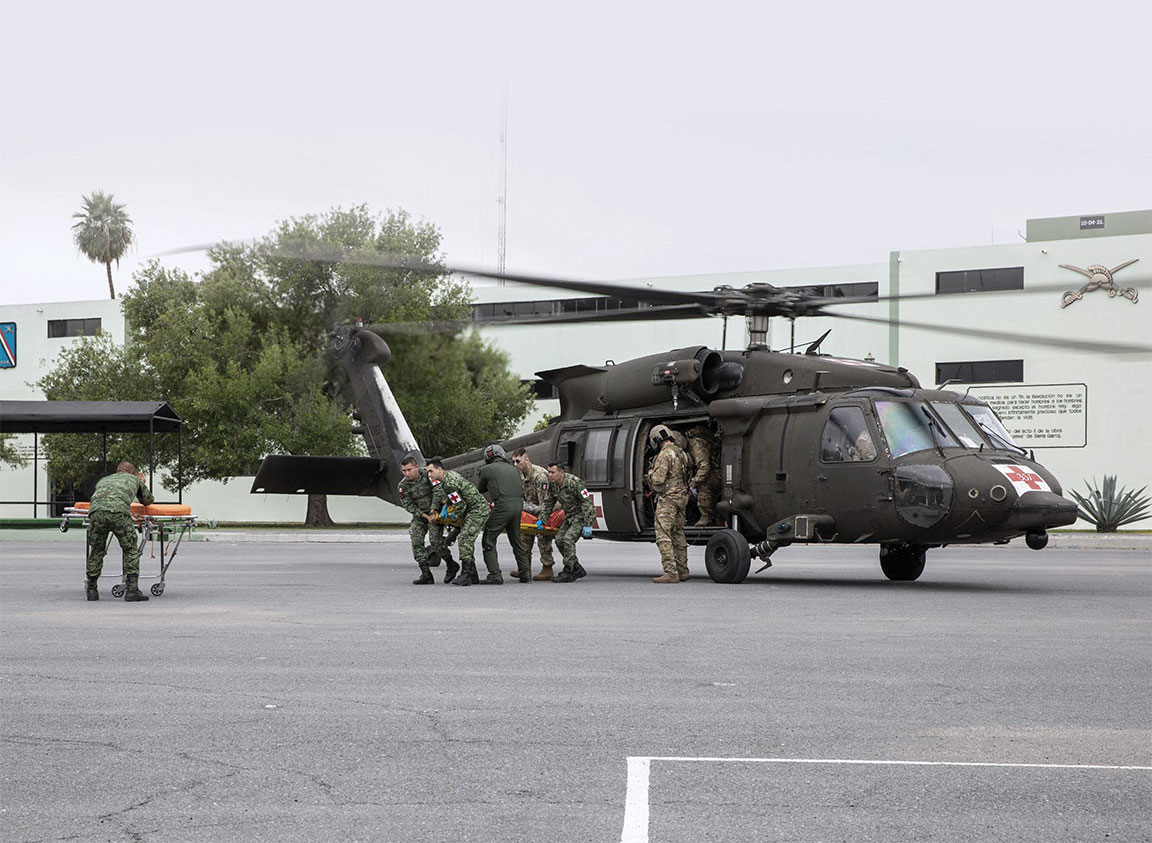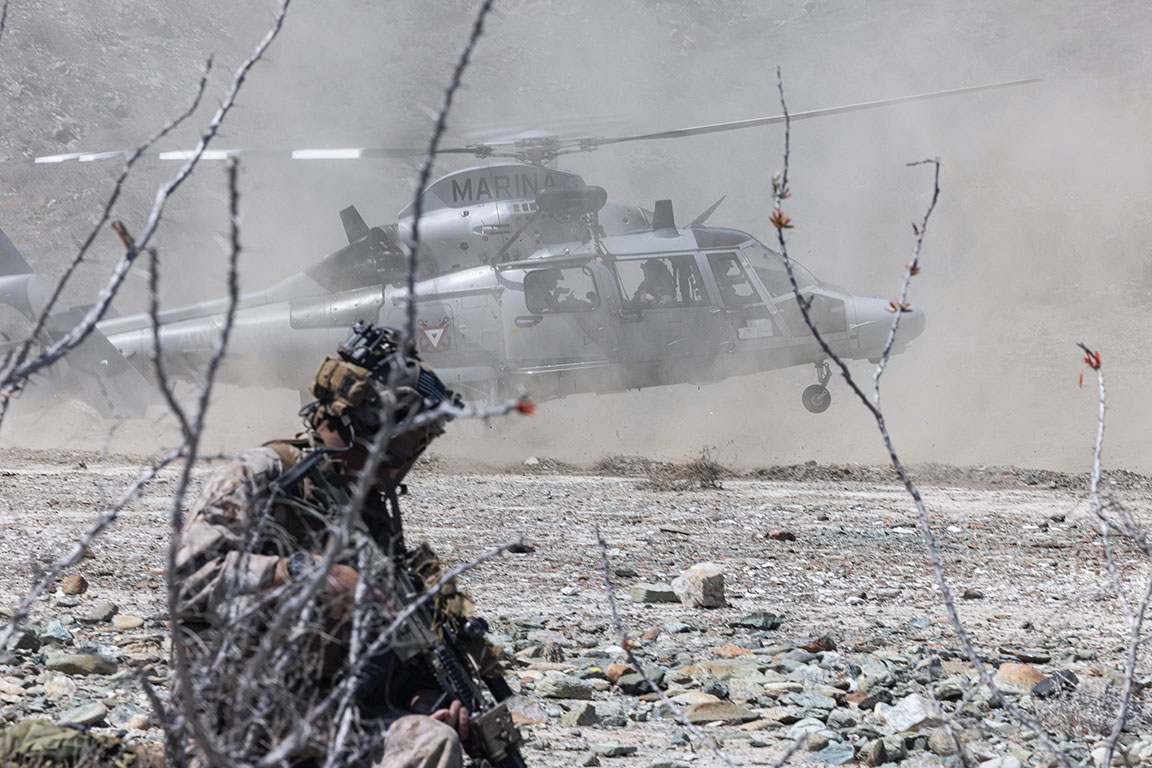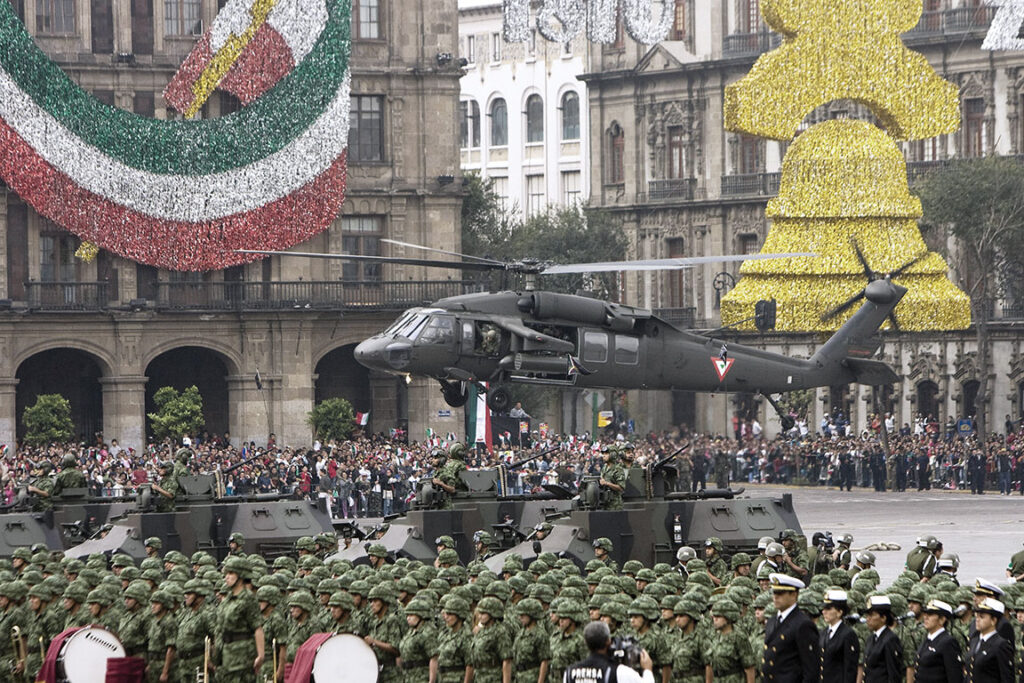A Mexican Blackhawk helicopter flies over a military parade for the 198th anniversary of Mexico’s independence at Zocalo Square in Mexico City on September 16, 2008. The Blackhawk is among several U.S.-supplied aircraft procured by the Mexican Armed Forces. AFP/GETTY IMAGES
DR. INIGO GUEVARA MOYANO/JANES STRATEGIC SERVICES
Mexico and the United States share much more than a 3,219-kilometer border and a complex history. Both nations share mutual problems and threats, but more importantly, they now share a common will on how to implement bilateral solutions.
While the militaries of both nations have traditionally had significantly different roles and missions, both aim to contribute to a more secure North America. The U.S. military has been primarily a globally focused, multipurpose, conventional/nuclear force. Mexico’s Armed Forces have traditionally focused on a variety of nation-building and humanitarian assistance and disaster response (HADR) missions.
The last time the two militaries fought side by side was during WWII, when the Mexican Expeditionary Air Force embedded with the 58th Fighter Group of the U.S. Army Air Forces to fight the Axis powers in the Pacific. While Mexico’s conventional contribution arrived in the latter part of the war, the Mexican state had taken up a series of structural and constitutional reforms to support the Allied war effort.
During the past 20 years, as the U.S. military transformed to support the global war on terror, Mexico’s Armed Forces adapted to take on a somewhat similar enhanced, countertransnational organized crime role. During this time, the militaries grew closer than they had in the previous 70 years.
Fifteen years ago, as the Merida Initiative began to take form, the Mexican and U.S. militaries scrambled to identify shared requirements and channels of communication that could enhance their understanding of each other. Enacted in December 2008, the initiative — a security cooperation agreement among Mexico, the countries of Central America and the U.S. to combat drug trafficking, transnational organized crime and money laundering — formed the basic framework for this enhanced cooperation. But soon after, both militaries found new points of connection.
While the pre-Merida relationship existed, it was mostly limited to HADR and border issues, with the latter dominated by counternarcotics. The relationship that has evolved during the Merida time frame is cemented on mutual trust, close communication and information sharing, from the strategic to the operational and tactical levels.

Mexican naval and military foreign liaison officers (FLO) have been posted to U.S. Northern Command since 2006 and 2008, respectively, and this paved the way for similar FLOs at a myriad of U.S. and U.S.-based agencies in what has been an unprecedented endeavor for Mexico’s previously inward-looking Armed Forces. Furthermore, Mexico-U.S. bilateral training exercises have led to airborne jumps and amphibious assault scenarios.
To harmonize these training exercises, processes and operations, Mexico’s Armed Forces have favored U.S.-supplied equipment over traditional European materials. U.S.-built Northrop Grumman AN/TPS-78 ground-based 3D radars form the backbone of the National Defense Secretariat’s (SEDENA) Aerospace Surveillance Integrated System, which is now being absorbed and expanded into a broader national aerospace surveillance system. The Mexican Army and Marines acquired several thousand High Mobility Multipurpose Wheeled Vehicles (HMMWV), while both the Mexican Air Force and Naval Aviation procured the Beechcraft T-6C Texan II and UH-60M Black Hawk as their standard tactical trainer and medium helicopter respectively, procuring over 70 of the former and 35 of the latter.
The Mexican Navy Secretariat (SEMAR) selected a European design for its next-generation frigate, known as the Long-Range Ocean Patrol program. The ship is armed with Boeing RGM-84L Harpoon Block II surface-to-surface missile launchers, Raytheon RIM-116 RAM Block II surface-to-air missiles and MK 54 Mod 0 torpedoes. It was selected in close cooperation with the United States. SEMAR also has aligned coastal and exclusive economic zone patrol craft and aircraft with those used by the U.S. Coast Guard and Border Patrol. It also added to its inventories the SAFE Boats Defender, Textron Motor Lifeboat, Damen Stan Patrol 4207 fast response cutter, Beechcraft King Air 350ER (MC-12), Airbus CN-235MPA Persuader (HC-144) and Airbus Helicopter AS565MBe Panther (MH-65).

As the global security context shifts following the Russian invasion of Ukraine in February 2022, Mexico and the U.S. are better coordinated to face external threats from encroaching competitors. While its security posture remains purely defensive, since September 2022, the Mexican Army and Air Force reintegrated phases 4th (Combined Arms) and 5th (Joint Operations) to their annual training curriculum at the Santa Gertrudis National Training Center, according to SEDENA documentation. These phases had been suspended since November 2006 as the Mexican military drifted away from large unit conventional operations.
This latest development foresees that the military mindset is aligned with that of the threats and common defense requirements facing North America.

